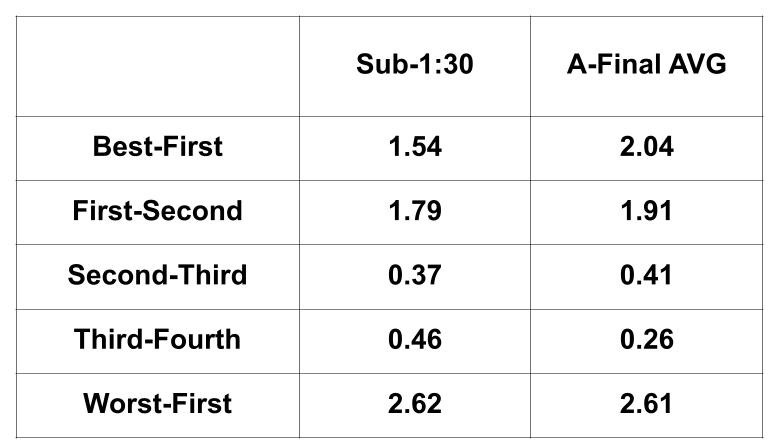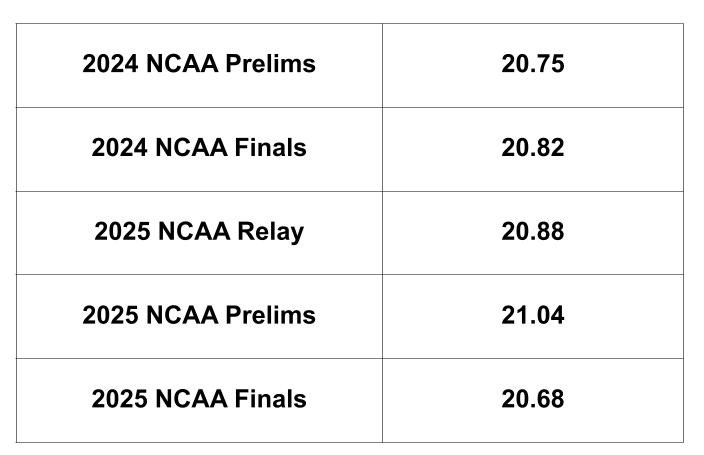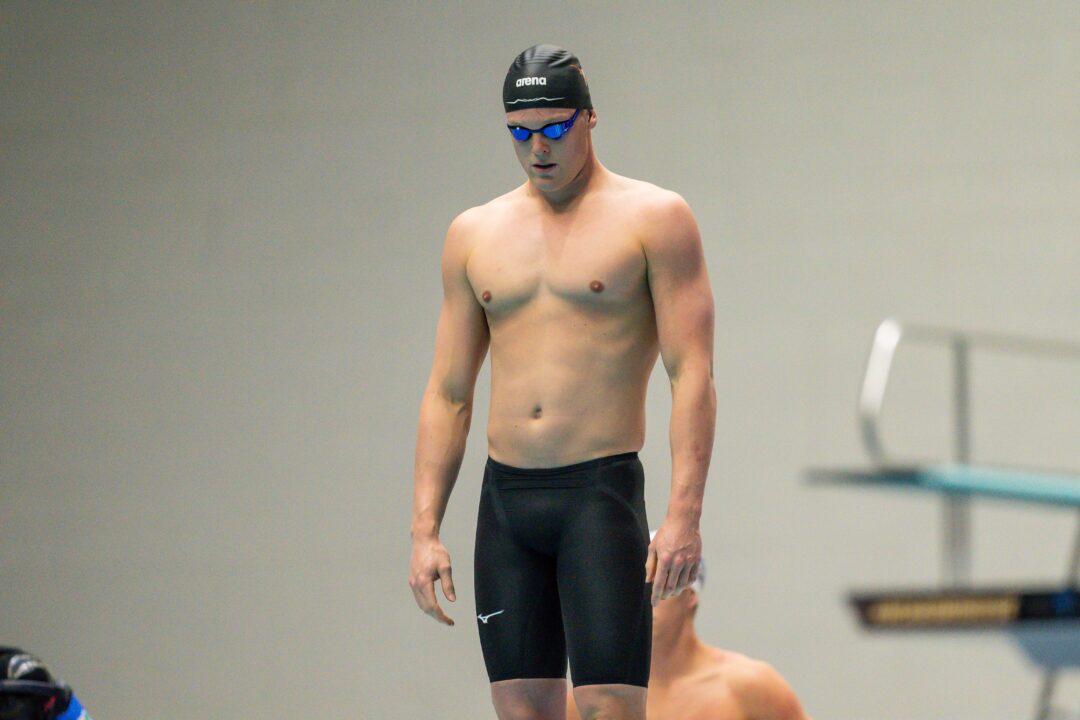Courtesy: Doug Cornish, the founder of Swimpler. Follow Swimpler on Substack here.
This is Volume 3 of How the Elite Race the 200 FR:
- Click HERE for Volume 1
- Click HERE for Volume 2
- Click HERE to access the 2015-2025 NCAA A-Final 200 FR Data Set
New tabs now available in the above data set:
- Men Sub 1:30
- Luke Hobson 14-21
- Luke Hobson Sub 1:30
- Women Sub 1:40
If I have misspelled a name or made a mistake, please message me with the details I need to correct it. As you can see, there is a lot of data here. I will welcome any chance to improve it.
THE SUB-1:30 CLASS
You can view all the splits and split differentials of the sub-1:30 class on Men Sub 1:30 tab in the excel spreadsheet linked above.
The Sub-1:30 class consists of 15 swims. Blake Pieroni became the founding member at the 2018 NCAA Men’s Championships, leading off the 800 FR relay. While his breakthrough may have been overshadowed by the historic 2018 meet, it quietly opened the door to a new performance frontier.
Since then, 7 men have broken the 1:30 barrier a total of 14 more times:
- 7 times leading off the 800 FR-Relay
- 5 Times in NCAA A-Finals
- 2 Times in NCAA Prelims (both Luke Hobson)
Luke Hobson holds 7 of the 15 sub-1:30 spots.
Kieran Smith did it twice, leading off the SEC and NCAA 800 FR-Relays in 2021.
From 2005 to 2015, the event hit a plateau. Simon Burnett (1:33.28) and Christian Quintero (1:32.03) bookend that data set with the fastest time during that span (1:31.20) being contributed by Burnett in 2006.
HOW DID WE SEE 15 SUB-1:30 SWIMS OVER THE NEXT 10 YEARS?
Easy money says they are going out harder. And I believed that – until yesterday.
Swimmers are going out faster.
Only one of the 15 sub-1:30 swims started with a 50 split over 21 seconds — Luke Hobson’s 21.04 at the 2025 NCAA Prelims.
But, I’m not sold that the reason they are going out faster is because they are going out harder.
The average speed of the first 50 of the 200 is improving at the same rate as the average speed of both the 50 FR and the 100 FR at NCAA. During the 2015-2025 time period:
- the average A-Final 50 FR time has improved from 19.20 to 18.40 – 4.2%.
- the average A-Final 100 FR time has gone from 42.22 to 40.55 – 4.0%
- the average 1st 50 split of the 200 FR has gone from 21.67 to 20.75 – 4.3%
Although sub-1:30 swimmers are going out faster, they’re not pushing the pace beyond what’s expected given the overall rise in sprint speed. In fact, the sub-1:30 group are hardly the only ones going out sub-21. Since 2016, a swimmer has gone out under 21 a total of 19 times at NCAAs without breaking 1:30, and those numbers don’t include relay lead-offs. Meanwhile, there are only two times in which the swimmer who posted the fastest 1st 50 won the race at NCAAs – both Townley Haas (2016, 2018).
The better, data-driven explanation for the sub-1:30 effort is that they are “building” the second 50 harder and “attacking” a little more on the third 50.
Ten of the 15 sub-1:30 swims have occurred since 2023. From 2023-2025, the average NCAA A-Final first-second 50 differentials were 1.99, 2.10, and 2.08 respectively. The average first-second 50 differential of the sub-1:30 group is 1.79.
Luke Hobson’s data-adjusted first-second 50 (covered later) is even faster.

Though derived from an extremely small data set, one statistic in the data supports the claim that the athletes are going out harder, the best-first 50 ratio. The sub-1:30 group have a best-first split ratio of 1.54. However, only 6 of those swimmers competed in the 50 at conferences or champs of the same season. This gives us a narrow window from which to observe how fast swimmers are going out relative to their top speed. The 1st 50 speed relative to best 50 is something to track in future swims.
LUKE HOBSON: A CASE STUDY
There are two tabs on the excel spreadsheet that contain Luke Hobson race splits and split differentials: Luke Hobson 14-21 includes the fastest swim from ages 14-17 that exists in SWIMS for which I can find splits in addition to every race in SWIMS from age 18-21. Luke Hobson Sub 1:30 shows all of his sub-1:30 swims.
LUKE & LEON
Worst-First is a ratio that gives us information about where and how much the swimmer faded. It is useful when assessing outcomes and evaluating race strategy.
Using the worst-first ratio, the two biggest split fades of the entire sub-1:30 group were demonstrated by Leon Marchand and Luke Hobson while leading off the 800 FR-R at 2024 NCAA Champs.
First night of 2024 NCAAs. Leon and Luke had both competed in the 200 M-R, Leon contributing a 22.59 BR split for ASU and Luke contributing an 18.82 anchor for Texas. Now they were both leading off the 800 FR-R. Texas in heat 2, ASU in heat 3.
- Luke’s first 50 – 20.28.
- Leon’s first 50 – 20.36.
At the 150, Luke’s split was .37 faster than Leon’s. Both swimmers faded hard. Luke faded harder. Luke faded and missed out on becoming the first sub-1:39 swimmer – last 50 was 24.16: worst-first of 3.88. Leon faded as well, but it he had just enough to become the first sub-1:39 swimmer – last 50 was 23.63: worst-first of 3.27.
The average worst-first of the sub-1:30 group is 2.62.
So what caused such a steep drop-off in two of the most well-conditioned swimmers in the world?
They got caught up in the moment, went out really fast, and bonked.
LUKE’S LESSON
Let’s compare the 20.28 to Luke’s other sub-1:30 efforts. That race against Leon was his second time breaking 1:30. The first time was a year prior leading off the 800 FR relay with an opening 50 of 20.99. He has broken 1:30 five times since: here are the first 50’s from those races.

It’s clear that Luke learned from that 2024 relay lead-off, exercising more control in his first 50. A year later leading off the 800 Fr-R his opening 50 was 20.88, a full 6 tenths of a seconds slower than the year prior. He went on to post an insane 22.67, 22.68, and 22.67 on his last three splits – worst-first of 1.79, best in the entire sub-1:30 class. Luke’s 5 sub-1:30 swims subsequent to his bonk against Leon contain the only 2 worst-first ratios under 2 seconds in the entire sub-1:30 class.
That is a lesson well-learned. One coaches and swimmers need to study.
His 5 swims since have been by design, not by chance.
When you remove the 2024 relay swim from the data, Luke’s split differentials look like this:
- Second 50 = 1.59 slower than first.
- Third 50 = .27 seconds slower than second.
- Fourth 50 = .42 seconds slower than third.
- Worst-First = 2.28
The NCAA 200 FR swimmers are an eclectic crew. There are distance swimmers ranging down, sprinters ranging up, and mid-distance swimmers in their sweet-spot. Luke doesn’t fit in either category. Having competed in the 100, 200, 500, and 1650 FR at Junior Nationals when he was 15, going sub-20 in the 50 in HS, and anchoring the 200 FR-R, he has range that most freestylers do not. That’s an important distinction when comparing how he sets up this race, and it highlights the need to acknowledge that the averages in the data don’t account for significant individual differences in the swimmers.
KEY TAKEAWAYS FOR COACHES AND SWIMMERS
This data is showing two important differences between sub-1:30 and the rest.
- First-50 speed regulation is critical.
- The best are shifting gears differently in the middle.
Elite swimmers die in the 200 FR.
Normalize the fact that these races are difficult. When you die, it’s ok. Learn from it, make positive changes, and move forward with better potential in your future swims.
Elite swimmers get caught up in the moment.
Swimmers, parents, and coaches. This is what we live for: to see these kids master the moment, not just their technique, strategy, and training. Despite sacrifice and rigorous preparation, the swimmers are not perfect. Expect them to get caught up in the moment now and then.
The best to ever do it still make mistakes.
The best swimmers train for years on end and still make mistakes on the big stage. Go further than normalizing mistakes. Make them a foundational unit of success.
Controlling the first 50 is the key that unlocks your mastery of the event. Luke Hobson’s trek through the sub-1:30 world shows us that even the best to ever do it need to control that first 50.
The best scrutinize the details more than the rest. At big meets, there is a video room. Does that room exist for the swimmers to compare notes on how many yards they’ve done – or is it for them to review footage of their technique and execution?
I’ve had far too many swimmers and parents ask when will we stop working on technique and train. Or, when will my swimmer know how to swim this race.
The best constantly tweak, analyze, and refine. They tinker more than the rest. When hundredths of a second can separate you from your competitor, you look under every rock and mine every piece of data for that .01.
The biggest takeaway for swimmers, parents, and coaches is to realize that the road to success is like that local road that everyone complains about – always under construction.
Next in the series I will tackle data trends, gender differences, and the incoming women’s assault on sub-1:40.
CREDIT FOR THE EDIT:
- Reader Casey Hnatiuk pointed out that Blake Pieroni was the first swimmer under 1:30. Thank you, Casey!

Wait until Pookie Hobson swims a 200 long course in a fast pool (French ppl don’t give af abt building a decent pool lmao typical). I predict 1:42.95!
This is AWESOME. More of this please!
This is actually really well analyzed and informational
Also 2015’s top qualifying time would have qualified 30th this year. Insane.
2015’s winning 1:32.03 would have been 19th in prelims this year.
ASU and Texas were in different heats of the 800 free relay at 2024 NCAAs
Yes! Thank you. I will edit.
You may not see my edit here. You will see it on my Substack, though. Casey…I’d like to give you credit for the edit. Please contact me at [email protected].